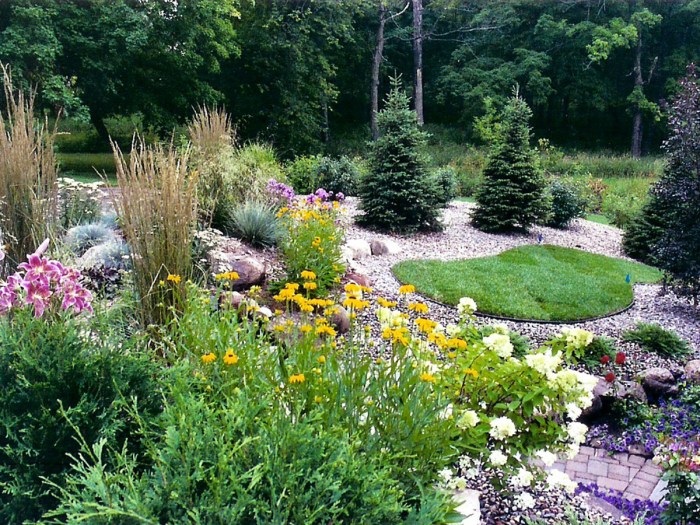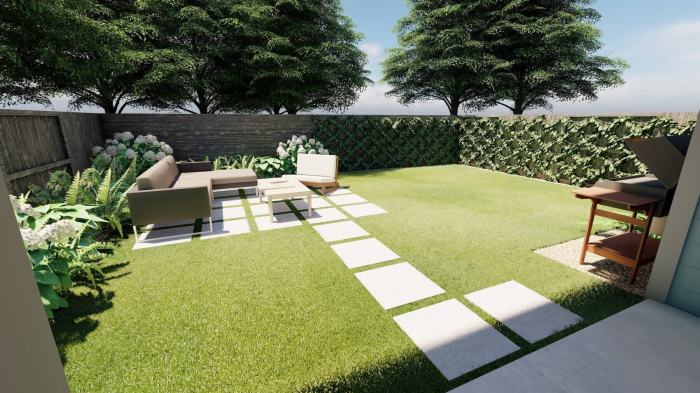Kicking off with Outdoor landscaping inspiration, this article explores the world of outdoor landscaping, from popular designs to sustainable practices, offering valuable insights for creating a picturesque outdoor oasis.
Whether you’re looking to revamp your backyard or create a cozy outdoor living space, this guide has everything you need to unleash your creativity and elevate your outdoor environment.
Outdoor Landscaping Ideas
When it comes to outdoor landscaping, the design possibilities are endless. From lush gardens to modern minimalist spaces, there are countless ways to transform your outdoor area into a beautiful oasis. Let’s explore some popular outdoor landscaping ideas that can inspire your own outdoor space.
Popular Outdoor Landscaping Designs
- Xeriscaping: This design focuses on using drought-tolerant plants and minimal water usage, making it perfect for arid climates.
- Cottage Garden: A charming and romantic style featuring an abundance of colorful flowers, whimsical pathways, and cozy seating areas.
- Modern Zen: Clean lines, simple shapes, and a focus on relaxation characterize this design, often incorporating elements like bamboo, rocks, and water features.
- Native Plant Landscape: Using plants that are indigenous to the area not only requires less maintenance but also supports local wildlife and ecosystems.
Use of Different Plants and Materials
Choosing the right plants and materials is crucial in creating a cohesive and visually appealing outdoor landscape. Consider the following:
- Native Plants: Opting for native plant species ensures they will thrive in the local climate and require less water and maintenance.
- Hardscape Elements: Incorporating materials like stone, wood, and gravel can add texture and visual interest to your outdoor space.
- Vertical Gardens: Utilizing vertical space with climbing plants or living walls can maximize space and add a touch of greenery.
Enhancing Outdoor Landscaping with Lighting
Lighting plays a crucial role in outdoor landscaping, not only providing functionality but also creating ambiance and highlighting key features. Consider the following lighting options:
- Path Lighting: Illuminate pathways and walkways for safety and aesthetics, guiding visitors through the outdoor space.
- Spotlights: Highlight focal points like trees, sculptures, or architectural elements to create drama and visual interest.
- String Lights: Add a warm and inviting glow to outdoor seating areas, creating a cozy atmosphere for gatherings and relaxation.
DIY Outdoor Landscaping Projects: Outdoor Landscaping Inspiration
Creating your own outdoor oasis doesn’t have to be costly or time-consuming. With a little creativity and some DIY skills, you can transform your outdoor space into a beautiful and functional area. Here are some step-by-step guides for DIY outdoor landscaping projects that you can easily tackle:
Creating a Small Garden in a Limited Space, Outdoor landscaping inspiration
If you have a small outdoor area but want to add some greenery, creating a small garden is a perfect solution. Here’s how you can do it:
- Choose the right location: Pick a spot that receives enough sunlight for your plants to thrive.
- Plan your layout: Use containers, raised beds, or vertical gardens to maximize space.
- Select your plants: Opt for compact varieties or plants that can thrive in small spaces.
- Regular maintenance: Water your plants regularly and ensure they have proper drainage.
Building a Simple Outdoor Patio Using Affordable Materials
Adding a patio to your outdoor space can create a cozy area for relaxing or entertaining. Here’s how you can build a simple outdoor patio on a budget:
- Choose your location: Decide where you want your patio and mark the area.
- Gather materials: You can use affordable options like gravel, pavers, or concrete blocks.
- Prepare the foundation: Level the ground, add a base layer of gravel, and compact it.
- Lay your materials: Arrange your pavers or concrete blocks in the desired pattern.
- Add finishing touches: Fill in the gaps with sand or gravel and add some outdoor furniture for a cozy touch.
Designing a Low-Maintenance Outdoor Landscaping Plan
For busy individuals who don’t have much time to tend to their outdoor space, a low-maintenance landscaping plan is the way to go. Here’s how you can design one:
- Choose easy-care plants: Select drought-tolerant or native plants that require minimal watering.
- Use mulch: Mulch helps retain moisture, suppress weeds, and reduce the need for frequent watering.
- Opt for hardscaping: Incorporate pathways, gravel areas, or rocks to minimize the need for lawn maintenance.
- Automate watering: Install a drip irrigation system or a timer for your sprinklers to ensure your plants are watered efficiently.
Sustainable Landscaping Practices

In today’s world, it is essential to incorporate sustainable practices into outdoor landscaping to minimize environmental impact and promote eco-friendly solutions. One of the key aspects of sustainable landscaping is the use of techniques that reduce water consumption, such as rainwater harvesting. By collecting rainwater and using it for irrigation, homeowners can reduce their reliance on municipal water sources and lower their water bills.
Benefits of Using Native Plants
Using native plants in outdoor landscaping offers numerous benefits. Native plants are adapted to the local climate and require less water, fertilizer, and maintenance compared to non-native species. They also provide habitat and food for local wildlife, promoting biodiversity in the ecosystem. Additionally, native plants are more resistant to pests and diseases, reducing the need for harmful pesticides.
Traditional vs. Sustainable Landscaping Methods
When comparing traditional landscaping methods to sustainable practices, there are significant differences in terms of cost and impact. While traditional landscaping may initially seem cheaper due to the use of non-native plants and chemical inputs, the long-term costs can be higher due to increased water usage, maintenance, and environmental damage. On the other hand, sustainable landscaping methods may require a higher upfront investment but result in lower maintenance costs, reduced water usage, and a healthier ecosystem in the long run.
Creating Outdoor Living Spaces

Creating a cozy outdoor living space is essential for enjoying your outdoor landscaping to the fullest. Whether you have a large backyard or a small patio, designing a comfortable seating area can make a big difference in how you use and appreciate your outdoor space.
Designing a Cozy Outdoor Seating Area
When designing a cozy outdoor seating area, consider the following tips:
- Choose comfortable and durable furniture that can withstand the elements.
- Add cushions, throw pillows, and blankets for extra comfort.
- Incorporate shade with umbrellas, pergolas, or shade sails to protect from the sun.
- Add lighting such as string lights, lanterns, or torches for ambiance and functionality.
- Create a focal point with a fire pit, outdoor fireplace, or water feature.
Importance of Privacy in Outdoor Living Spaces
Privacy is crucial in outdoor living spaces to create a sense of intimacy and relaxation. To enhance privacy:
- Use landscaping elements like hedges, trees, or tall plants to create a natural barrier.
- Add privacy screens, fences, or walls to block views from neighboring properties.
- Consider outdoor curtains, shades, or blinds for a flexible and stylish privacy solution.
- Create cozy nooks or hidden retreats within your outdoor space for a secluded feel.
- Strategically position furniture or accessories to create visual barriers and enhance privacy.
Integrating Water Features for a Calming Effect
Water features can add a sense of tranquility and relaxation to your outdoor living space. Here’s how to integrate them:
- Consider adding a fountain, pond, or water wall for a soothing sound and visual appeal.
- Incorporate water plants like lilies, lotus, or water hyacinths for a natural touch.
- Install a small stream or waterfall to create movement and interest in your outdoor space.
- Use lighting to highlight water features at night for a magical and calming effect.
- Ensure proper maintenance to keep water features clean, functional, and safe for both people and wildlife.